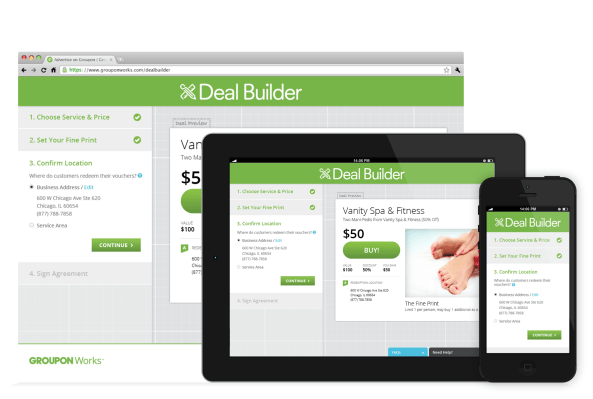Groupon — on a mission to expand its business beyond the daily deal and into more local commerce (a mission to be partly fuelled by Apple Pay) — is also making efforts to ensure that the inventory of offers that it does have continues to grow. As part of that, Groupon is updating its Deal Builder, a do-it-yourself tool it launched in February for merchants to create and upload their own offers to Groupon, without working with live sales reps.
Restaurants, one of Groupon’s biggest categories, can now also create their own deals (they were not eligible before). And Groupon has also added in more pricing, photographic and editorial features to the Deal Builder — the logic here being that more flexible deal choices, nicer pictures and better descriptions will draw in more merchants as we all more users.
Up to now, the most popular categories on the Deal Builder platform have been photography, automotive, cleaning), beauty and wellness (salons and spas), leisure and activities (fitness) and retail and shopping, Groupon says.
But although Groupon has a pretty large international operation (more than half of its daily deals come from outside the U.S.) Deal Builder is still only live in North America.
Groupon says that since the Deal Builder launched in February this year, over 25,000 deals have been built on it. That’s pointed to some success for the company: in North America in Q2, Groupon tallied up some 105,000 deals, out of 240,000 globally. In other words, the Deal Builder is likely already accounting for double-digit percentages of deals (likely because the 25,000 figure is aggregated between February and today, not just for the quarter).
It’s also potentially bringing in a new class of small business customers. The original idea for the tool was to cater to businesses that might be too small or offer too infrequent a series of deals to necessarily work directly with sales reps.
At the same time, it offered a way of expanding Groupon’s inventory of deals, which becomes a reason for people to visit the site more frequently to supplement the email hooks that Groupon used for its early viral growth, and mobile apps.
This has been borne out — as least in the initial flush of usage. Groupon says that some 95% of the businesses that use the Deal Builder are new to Groupon. Still, the key metric will likely be, how many of those new merchants return? Groupon is mum on this point; we’re asking to see if we can get more detail.
Update: A Groupon spokesperson tells us the following: “Since we’re no longer a daily deals site in the sense that merchants run a deal for a week and then go off the site, most of these businesses build a deal that lives in our marketplace on a continuous basis. The stat that we make publicly available (which isn’t specific to just Deal Builder) is that more than 75% of Groupon’s North American merchants opt to be featured in our marketplace on an ongoing basis.”
“Deal Builder has enabled us to vastly expand the number of merchants with whom we work and enhance the ways we help them promote and build their business through Groupon,” said Julie Szudarek, SVP, Local Deals, in a statement. “More than 95 percent of the businesses that have built deals through the platform have been new to Groupon, which has helped us expand the selection and geographic reach of our marketplace.”
It appears that part of the reason that restaurants were excluded from the Deal Builder initially had to do with getting the platform up and running.
With restaurants being one of the most popular categories on Groupon — and one that the company has been pushing hard with acquisitions like Breadcrumb and the expansion of services catering specifically to food businesses — getting the Deal Builder to work without glitches and offer the kinds of graded discounts, and more visual presentations, that restaurants might like to feature was essential.
